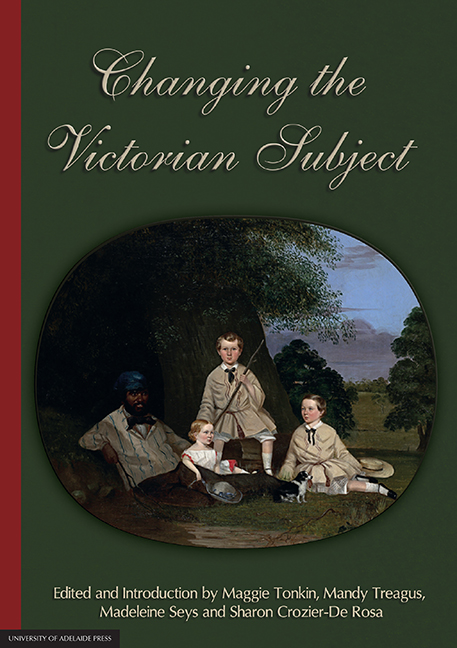Book contents
- Frontmatter
- Contents
- Notes on Contributors
- 1 Re-visiting the Victorian subject
- 2 Queen Victoria's Aboriginal subjects: a late colonial Australian case study
- 3 Identifying with the frontier: Federation New Woman, Nation and Empire
- 4 A ‘Tigress’ in the Paradise of Dissent: Kooroona critiques the foundational colonial story
- 5 The making of Barbara Baynton
- 6 A literary fortune
- 7 Olive Schreiner's From Man to Man and ‘the copy within’
- 8 Guy Boothby's ‘Bid for Fortune’: constructing an Anglo-Australian colonial identity for the fin-de-siècle London literary marketplace
- 9 The scenery and dresses of her dreams: reading and reflecting (on) the Victorian heroine in M.E. Braddon's The Doctor's Wife
- 10 The woman artist and narrative ends in late-Victorian writing
- 11 Miss Wade's torment: the perverse construction of same-sex desire in Little Dorrit
- 12 ‘All the world is blind’: unveiling same-sex desire in the poetry of Amy Levy
- 13 From ‘Peter Panic’ to proto-Modernism: the case of J.M. Barrie
3 - Identifying with the frontier: Federation New Woman, Nation and Empire
Published online by Cambridge University Press: 05 December 2014
- Frontmatter
- Contents
- Notes on Contributors
- 1 Re-visiting the Victorian subject
- 2 Queen Victoria's Aboriginal subjects: a late colonial Australian case study
- 3 Identifying with the frontier: Federation New Woman, Nation and Empire
- 4 A ‘Tigress’ in the Paradise of Dissent: Kooroona critiques the foundational colonial story
- 5 The making of Barbara Baynton
- 6 A literary fortune
- 7 Olive Schreiner's From Man to Man and ‘the copy within’
- 8 Guy Boothby's ‘Bid for Fortune’: constructing an Anglo-Australian colonial identity for the fin-de-siècle London literary marketplace
- 9 The scenery and dresses of her dreams: reading and reflecting (on) the Victorian heroine in M.E. Braddon's The Doctor's Wife
- 10 The woman artist and narrative ends in late-Victorian writing
- 11 Miss Wade's torment: the perverse construction of same-sex desire in Little Dorrit
- 12 ‘All the world is blind’: unveiling same-sex desire in the poetry of Amy Levy
- 13 From ‘Peter Panic’ to proto-Modernism: the case of J.M. Barrie
Summary
Introduction
As the colonial period advanced, negative aspects of the Australian bush were often figured as feminine, represented as harsh, un-nurturing, and barren; as a land hostile to man's desires to conquer or even to just survive. But, by the late nineteenth century, the bush was rarely imagined as a place for women (Schaffer, Women and the Bush 52-76). Likewise, the emerging new Australian nation was increasingly symbolised as female — as Britannia's daughter or younger cousin, for example. At the turn of the twentieth century, however, the role of women in the construction of that new nation was rarely acknowledged. Late-nineteenth and early-twentieth-century Australia then provided little place for women in imaginings of either the bush or the nation, despite the paradoxical reality of women's active involvement in both as, for instance, pastoral workers or as voters. More than ever in white Australian history, women were imaginatively consigned to the domestic hearth, to British middle-class notions of domestic ideology.
Catherine Martin's New Woman novel, An Australian Girl (1890), published and sold in both Australia and Britain, challenged these gendered omissions. Critically well-received in both the imperial metropole and colonial peripheries, An Australian Girl not only feminised the Australian landscape, it also injected the Australian woman into national imaginings. In telling the story of South Australian New Woman, Stella Courtland — by tracing her connection with and love for the untamed, ‘uncivilised’ land — this novel made visible the woman in the bush.
- Type
- Chapter
- Information
- Changing the Victorian Subject , pp. 37 - 58Publisher: The University of Adelaide PressPrint publication year: 2014



